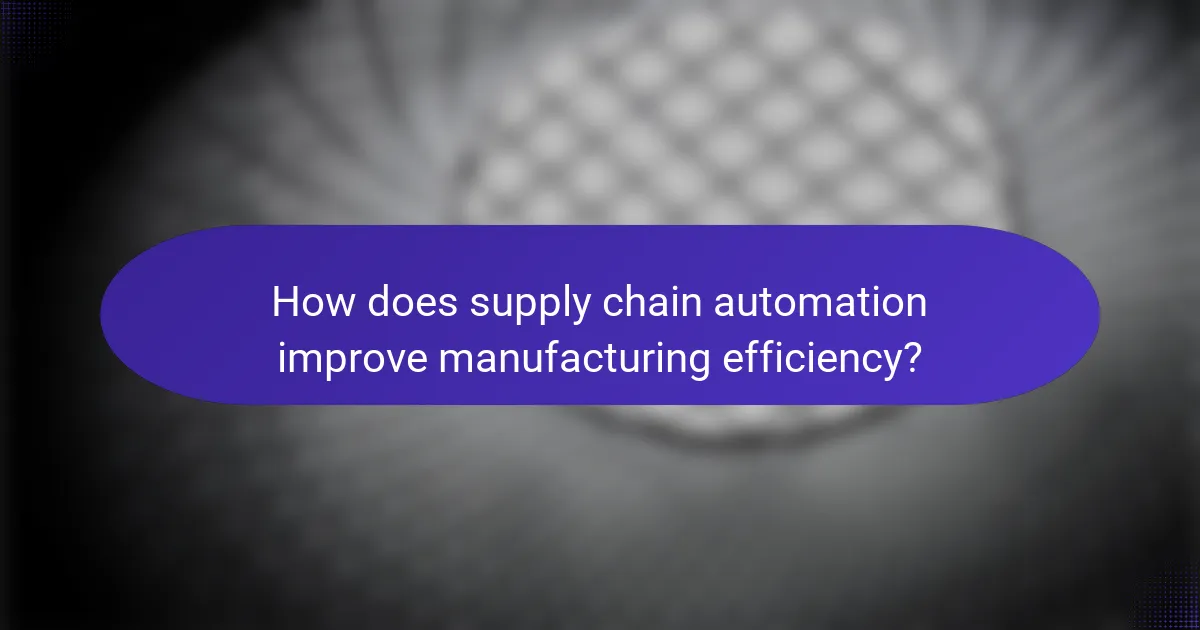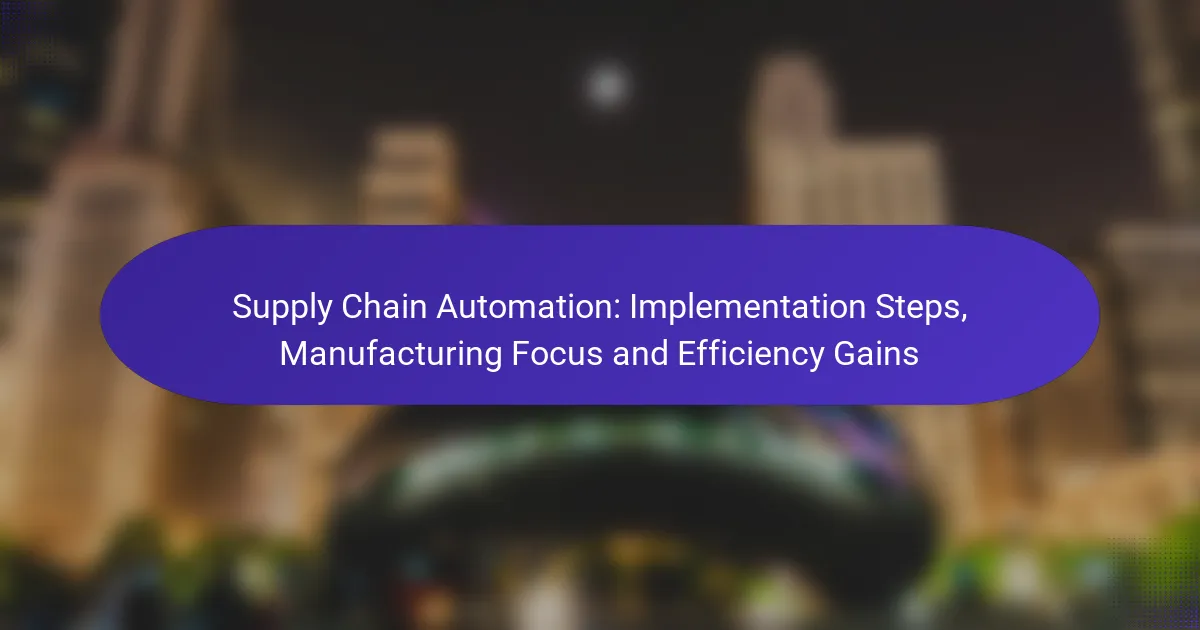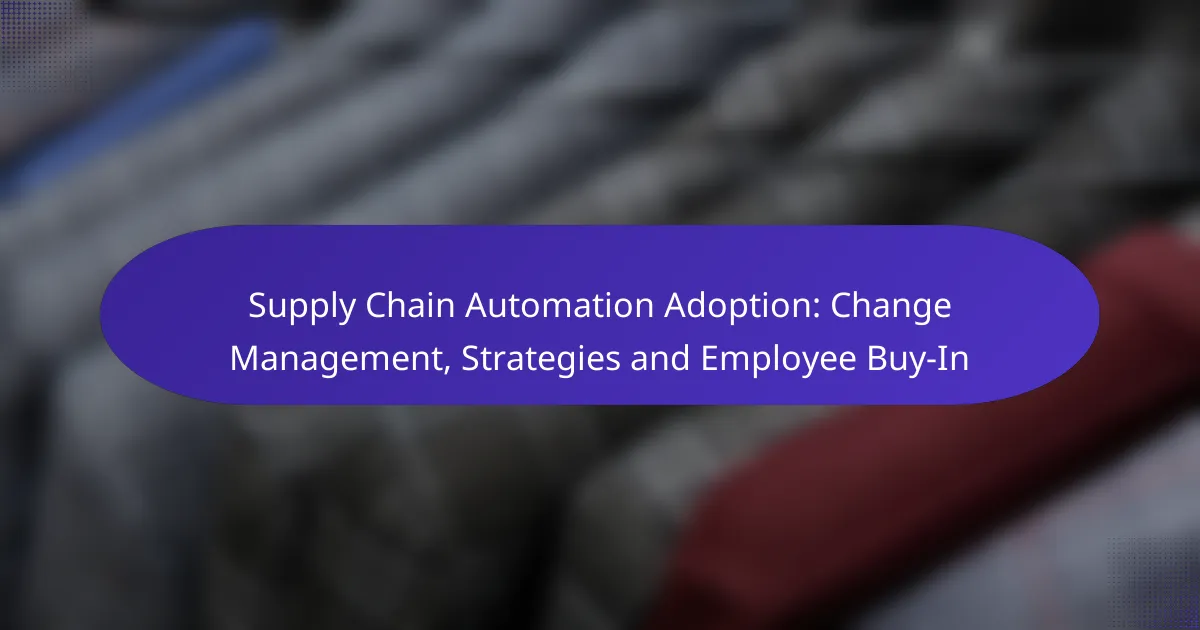Supply chain automation is a transformative approach that enhances operational efficiency through a structured implementation process. By integrating advanced technologies such as Robotic Process Automation, Artificial Intelligence, and the Internet of Things, manufacturers can streamline their operations, reduce delays, and improve resource management, ultimately leading to faster production cycles and minimized errors.

What are the implementation steps for supply chain automation?
Implementing supply chain automation involves a series of structured steps that enhance efficiency and streamline operations. Key stages include assessing current processes, selecting appropriate technology, planning for integration, managing training, and continuously monitoring performance.
Assessment of current processes
Begin by evaluating existing supply chain processes to identify inefficiencies and bottlenecks. This assessment should involve mapping out workflows, analyzing data, and gathering feedback from stakeholders to understand pain points.
Consider using tools like process mapping software to visualize workflows and pinpoint areas for improvement. This foundational step ensures that automation targets the most impactful areas, leading to significant efficiency gains.
Technology selection
Selecting the right technology is crucial for successful supply chain automation. Evaluate various software solutions and hardware options that align with your specific needs, such as inventory management systems, robotics, or AI-driven analytics.
Focus on scalability and compatibility with existing systems. Conducting pilot tests with shortlisted technologies can help determine the best fit before full-scale implementation.
Integration planning
Integration planning involves ensuring that new automation technologies work seamlessly with current systems. Develop a clear roadmap that outlines how different components will interact, including data flow and communication protocols.
Engage IT teams early in the process to address potential challenges and ensure a smooth transition. A well-thought-out integration plan minimizes disruptions and maximizes the benefits of automation.
Training and change management
Training employees on new technologies is essential for successful implementation. Create comprehensive training programs that cover both technical skills and changes in workflow resulting from automation.
Implement change management strategies to help staff adapt to new processes. Encourage open communication and provide ongoing support to address concerns and resistance to change.
Monitoring and optimization
After implementation, continuously monitor the performance of automated systems to ensure they meet desired outcomes. Use key performance indicators (KPIs) to evaluate efficiency, accuracy, and cost savings.
Regularly review processes and gather feedback to identify areas for further optimization. This iterative approach allows for adjustments that enhance overall supply chain performance and adaptability to market changes.

How does supply chain automation improve manufacturing efficiency?
Supply chain automation significantly enhances manufacturing efficiency by streamlining processes, reducing delays, and minimizing errors. By integrating technology into supply chain operations, manufacturers can achieve faster production cycles and better resource management.
Reduction of lead times
Automating supply chain processes can lead to a substantial reduction in lead times, which is the duration from order placement to delivery. By using automated systems for inventory management and order processing, manufacturers can cut lead times from days to hours or even minutes.
For instance, automated inventory systems can trigger reorders when stock levels fall below a certain threshold, ensuring that materials arrive just in time for production. This just-in-time approach helps maintain smooth operations and reduces the need for excess inventory.
Minimization of human error
Human error is a common issue in manual supply chain processes, often leading to costly mistakes such as incorrect orders or inventory discrepancies. Automation minimizes these errors by standardizing processes and using technology to handle repetitive tasks.
For example, automated data entry systems can eliminate the inaccuracies associated with manual input, ensuring that information is consistently accurate. This reliability not only enhances efficiency but also builds trust with suppliers and customers.
Enhanced data visibility
Supply chain automation provides real-time data visibility, allowing manufacturers to track inventory levels, order statuses, and production schedules more effectively. This transparency enables quicker decision-making and better responsiveness to market changes.
With advanced analytics tools, manufacturers can analyze trends and forecast demand more accurately, leading to improved planning and resource allocation. Enhanced visibility also facilitates collaboration among supply chain partners, fostering a more integrated approach to operations.

What are the key technologies in supply chain automation?
The key technologies in supply chain automation include Robotic Process Automation (RPA), Artificial Intelligence (AI), and the Internet of Things (IoT). These technologies streamline operations, enhance decision-making, and improve overall efficiency in supply chain management.
Robotic Process Automation (RPA)
Robotic Process Automation (RPA) involves the use of software robots to automate repetitive tasks within supply chain processes. This can include data entry, order processing, and inventory management, allowing human workers to focus on more strategic activities.
When implementing RPA, it’s crucial to identify processes that are rule-based and high-volume. Common pitfalls include underestimating the complexity of integration with existing systems and neglecting to involve end-users in the design phase. A successful RPA project often starts with a pilot program to test its effectiveness before full-scale deployment.
Artificial Intelligence (AI)
Artificial Intelligence (AI) enhances supply chain automation by providing advanced analytics and predictive capabilities. AI can analyze vast amounts of data to forecast demand, optimize inventory levels, and improve supplier selection.
To leverage AI effectively, organizations should focus on data quality and ensure they have the necessary infrastructure to support AI applications. Investing in AI tools can yield significant efficiency gains, but companies must be prepared for a learning curve as algorithms are trained and refined over time.
Internet of Things (IoT)
The Internet of Things (IoT) connects devices and sensors across the supply chain, enabling real-time data collection and monitoring. This technology allows for better visibility into inventory levels, shipment conditions, and equipment performance.
Implementing IoT requires careful planning around data security and network infrastructure. Companies should consider starting with a few key use cases, such as tracking temperature-sensitive goods, to demonstrate value before expanding their IoT initiatives. Effective IoT deployment can lead to reduced waste and improved responsiveness to market changes.

What are the challenges of implementing supply chain automation?
Implementing supply chain automation presents several challenges that organizations must navigate to achieve efficiency. Key obstacles include high initial investments, resistance to change from employees, and concerns regarding data security.
High initial investment
The upfront costs of supply chain automation can be significant, often requiring investment in technology, infrastructure, and training. Companies may need to allocate budgets in the low to mid six figures, depending on the scale of automation desired.
To mitigate financial strain, organizations can consider phased implementation, starting with critical areas that promise the highest return on investment. This approach allows for gradual integration while managing costs effectively.
Resistance to change
Employees may resist adopting new automated systems due to fear of job loss or discomfort with unfamiliar technology. Addressing these concerns is crucial for successful implementation.
Engaging staff through training sessions and transparent communication can help ease the transition. Highlighting the benefits of automation, such as reduced workload and enhanced job satisfaction, can also foster a more positive attitude towards change.
Data security concerns
As supply chain automation relies heavily on data exchange, concerns about data security and privacy are paramount. Organizations must ensure compliance with relevant regulations, such as GDPR in Europe, to protect sensitive information.
Implementing robust cybersecurity measures, including encryption and regular audits, can help safeguard data. Additionally, educating employees about best practices for data handling is essential to minimize risks associated with automation.

What criteria should be considered when choosing automation solutions?
When selecting automation solutions, consider factors such as technology scalability, integration capabilities, and cost-effectiveness. These criteria will help ensure that the chosen system aligns with your manufacturing goals and can adapt to future needs.
Scalability of technology
Scalability refers to the ability of automation technology to grow and adapt as your business needs change. A scalable solution can handle increased production volumes without requiring a complete overhaul, making it a cost-efficient choice in the long run.
When evaluating scalability, assess whether the technology can easily integrate additional machines or software as your operations expand. For example, a modular automation system allows you to add components incrementally, which can be more manageable than investing in a large-scale system all at once.
Additionally, consider the potential for future upgrades. Choose solutions that are compatible with emerging technologies and industry standards, ensuring your investment remains relevant and effective over time.



